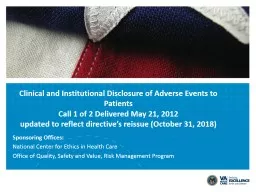PPT-Critical Thinking about Institutional Disclosure
Author : alexa-scheidler | Published Date : 2018-10-29
of Adverse Events to Patients August 6 2012 updated 4182016 Call 2 of 2 Sponsoring Offices National Center for Ethics in Health Care Office of Quality Safety
Presentation Embed Code
Download Presentation
Download Presentation The PPT/PDF document "Critical Thinking about Institutional Di..." is the property of its rightful owner. Permission is granted to download and print the materials on this website for personal, non-commercial use only, and to display it on your personal computer provided you do not modify the materials and that you retain all copyright notices contained in the materials. By downloading content from our website, you accept the terms of this agreement.
Critical Thinking about Institutional Disclosure: Transcript
Download Rules Of Document
"Critical Thinking about Institutional Disclosure"The content belongs to its owner. You may download and print it for personal use, without modification, and keep all copyright notices. By downloading, you agree to these terms.
Related Documents














